The Day After Tomorrow: Into Infinity
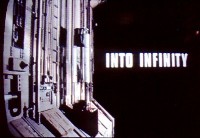
In 1975 George Heinemann, vice-president of children's programming for NBC Television in the US, devised Special Treat, a series of eight one-hour educational films. One of these would illustrate Einstein's Theory of Relativity, in a dramatic adventure that would appeal to children. Heinemann commissioned Gerry Anderson, producer of the forthcoming new science fiction series Space: 1999, to make this one-off film.
In the story created by Gerry Anderson and writer Johnny Byrne, two families would travel into space on a spaceship that travelled at the speed of light. The film was titled The Day After Tomorrow. It was devised as a potential pilot episode for a series, so the film had a second title, the episode name Into Infinity. When the special was shown on the BBC in 1976, the first (series) title was removed so as not to confuse the audience with two titles. The film's budget was £120,000.
Byrne's script was dated 27 June 1975, with amendments 3 July. The film was filmed at Pinewood Studios in 10 days from 21st July to 1st August 1975, between the two series of Space: 1999, using many of the cast and crew from the series. The film even looks like an episode of Space: 1999, and an obvious precursor for the Year Two changes, in design, music and action-based plot. Stars Nick Tate and Brian Blessed were veterans of the series, costumes and sets were recycled from 1999 (or would be reused in Year Two), and a spaceship was designed by model maker Martin Bower thinking Into Infinity was in fact an episode of Space: 1999.
However, the story is intended for children. It includes two child actors and there are scientific explanations for educational value (of the Doppler effect, of Einstein's life and theories, and how red giant stars explode as supernovae).
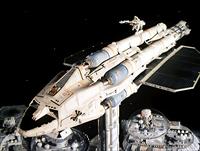
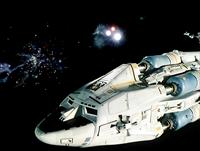
It was shown as the third programme of the NBC Special Treat series on December 9th, 1975. It received its UK premiere on BBC 1 at 6pm on Saturday 11th December, 1976, cutting the "Day After Tomorrow" title credit, so it was known only as "Into Infinity". In the UK it was repeated in December 1977.
It was re-shown in the UK on BBC 4 on November 9th, 2014 at 22:50 (sadly not HD as advertised).
The film length is 52 minutes. When the BBC broadcast the film, they removed the caption The Day After Tomorrow., so the film would only have one title (Into Infinity). This was the only cut. A listing error on some internet sites record the length as 80 minutes, and inspired a rumour that an extended version exists. The 52 minute version is the only version, and the only UK TV cut was the title frame.



Johnny Byrne had written 8 episodes of the first series of Space: 1999, and was preparing three scripts for the second series as well as writing the script of Into Infinity. His dog Bones made a brief appearance as the family pet Spring, who gets left on Space Station Delta. 1992 Johnny Byrne interview
Charles Crichton directed the film. Legendary film director Crichton had directed 8 episodes of the first year of Space: 1999 and would direct 6 more of the second.
Brian Johnson and Nick Allder did the special effects. For the film they made more extensive use of freon gas to simulate rockets firing in space, a technique carried on in the second series of Space: 1999. They also developed the space warp effect, with amorphous colourful clouds flying past the ship as it accelerated. The effect was later used for space warps in Year Two of Space: 1999 (during the titles and the episode Space Warp).
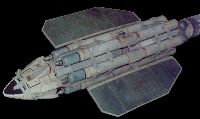
Model maker Martin Bower thought the film was another episode of Space: 1999 and thus designed models that looked very like 1999 spaceships. He built the lightship Altares in two scales, a large 6 foot (184cm) long version and a 3 foot (96cm) long version. At the studio Terry Reed added an antennae on top of the ship, made from the gravity towers that surrounded Moonbase Alpha in Space: 1999 Year One. More photos
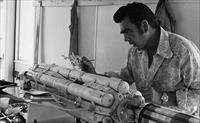
Cyril Forster touches up the antennae on top of the ship. This is a lightly modified gravity tower from Space: 1999, which conveniently existed in multiple sizes for the two different Altares scales.
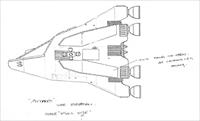
Early Martin Bower design sketch (see more). In one, the original name of "Orion" is crossed out and replaced by "Altares". Two of the sketches are dated 8th April 1975 (each is a different version of the command module). On the command module, undercarriage doors which house the landing legs are indicated.
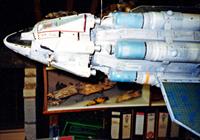
The models were displayed at Space City in Blackpool (1977-1981), Alton Towers amusement park (1982-1989) and here in Phil Rae's attic.
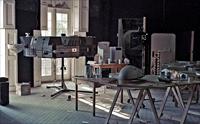
The 15 foot long model of the spaceship Daria, from the episode Mission Of The Darians, was cannibalised to make spacestation Delta for the film. Parts would later be seen as buildings of Moonbase Alpha in Space: 1999 Year Two. This photo shows it being built in the ballroom studio of Bray Studios (the Moon from 1999 can be seen through the door). Note the boxes for Airfix Hawker Harrier and Tamiya Chieftain tank, used for kit parts. More photos
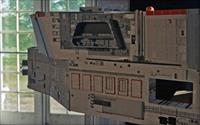
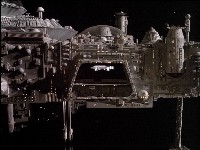
The isosceles trapezoid on the Delta is the Daria docking port, lined with Revell Gemini stabilising rockets. Top left are 2 of the 4 Gemini battery housings.
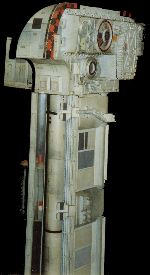
This docking tower for the Altares was made for the film. The top part of the model reappears in the Eagle hangar in Space Warp. The lift capsule seen rising to the Altares used a door from a Moonbase tank seen in the episode The Infernal Machine.
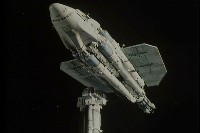
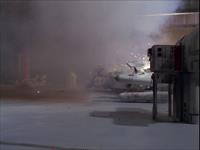
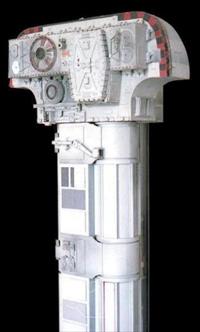
The Altares docking tower. The head section of the tower was removed for Space Warp, which explains why the tower section is reordered.
Bower also made the UN shuttle, inspired by the shape of Thunderbird 2, from Gerry Anderson's Thunderbirds. The small satellites that the Altares launches reappear in the spaceship graveyard in The Metamorph.
Production design was by Space: 1999 producer Reg Hill (Keith Wilson was working on Star Maidens). The pilot control panels were revamped from those of Voyager in Voyager's Return (they later appeared as the Weapons Section in Year Two). The reactor door had previously been seen in Force Of Life and would be recycled again in The Beta Cloud. The colourful computer panels from the film were used prominently in Command Center in the second series of Space: 1999 (complete with original labels for "Photon Drive", and "Yaw" and "Pitch"). The firesuit that Nick Tate wears (made by Bestobell Engineering Products Ltd of Slough) would be seen again on Alphan firemen in Space: 1999 Year Two. The jackets worn by the Altares crew anticipated the jackets that Year 2 Alphans would wear.
Music was by Derek Wadsworth, who went on to provide the music for Space: 1999 Year Two. He worked with Steve Coe, a songwriter recently out of college who had some experience with synthesisers. Some of Coe's synthesiser tracks for the film would be used as sound effects in Space: 1999. The original 24-track master soundtrack were kept by the publishers, Panache Music, but after the owner died in 1976 the tapes were lost. Wadsworth kept a 2-track copy, which he eventually loaned to a record producer in the US. The producer put the tapes in his briefcase in the car at the Los Angeles airport, but the briefcase was stolen.
Other crew members who had worked on Space: 1999 included director of photography Frank Watts, editor David Lane, make up by Connie Reeve and music editor Alan Willis.
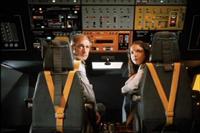
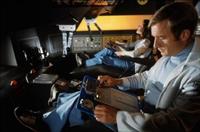
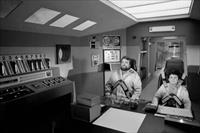
The adult cast had all worked with Gerry Anderson before, most of them on the first series of Space: 1999.
Copyright Martin Willey. Thanks to Marcus Lindroos. All photographs by Phil Rae.